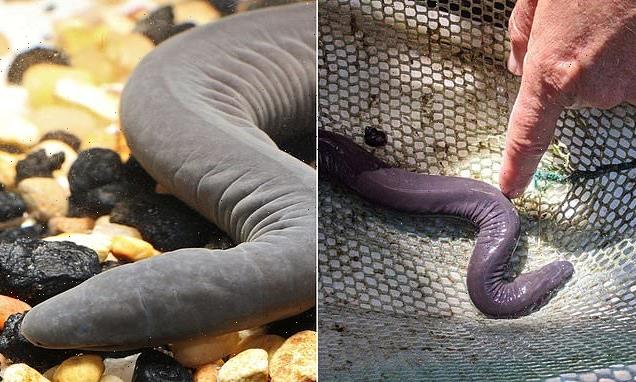Weight-loss treatment that makes mice SWEAT out fat could work on humans too – but it will leave you with greasy hair
- New weight-loss treatment that makes mice ‘sweat’ out fat has been discovered
- Researchers say the treatment could even be used on humans to tackle obesity
- A cytokine – a type of immune system protein – was found to trigger weight loss
- Does so by targeting immune system and inducing sweat, leading to greasy hair
A new weight-loss treatment that makes mice ‘sweat’ out fat has been discovered by scientists — who say it could even be used on humans to tackle obesity.
Researchers found it is possible to induce stomach fat loss by targeting the immune system, although the knock-on effect is greasy hair.
They made the discovery after treating mice with the cytokine thymic stromal lymphopoietin (TSLP) — a type of immune system protein — which led to significant fat and weight loss.
Scroll down for video
A new weight-loss treatment that makes mice ‘sweat’ out fat has been discovered by scientists — who say it could even be used on humans to tackle obesity (stock image)
WHAT IS THE CYTOKINE TSLP AND HOW MIGHT IT HELP WITH WEIGHT LOSS?
Researchers treated mice with the cytokine thymic stromal lymphopoietin (TSLP) — a type of immune system protein which is involved in asthma and other allergic diseases.
They found that it led to significant fat and weight loss but it was not caused by a decreased food intake or faster metabolism.
Instead it was because the TSLP stimulated the immune system to release lipids through the skin’s oil-producing sebaceous glands.
This reversed obesity in the mice and reduced their weight from 45g to a healthy 25g over a four-week period.
TSLP-treated mice also saw a decrease in their visceral fat mass — the white fat that is stored in the abdomen around major organs, which can increase diabetes, heart disease and stroke risk.
Unexpectedly, however, this was not caused by a decreased food intake or faster metabolism, but instead because the TSLP stimulated the immune system to release lipids through the skin’s oil-producing sebaceous glands.
‘This was a completely unforeseen finding, but we’ve demonstrated that fat loss can be achieved by secreting calories from the skin in the form of energy-rich sebum,’ said the study’s lead author Taku Kambayashi, from the University of Pennsylvania.
‘We believe that we are the first group to show a non-hormonal way to induce this process, highlighting an unexpected role for the body’s immune system.’
Kambayashi said the findings support the possibility that increasing sebum production via the immune system could be a strategy for treating obesity in humans.
Researchers were investigating the role of TSLP, which is involved in asthma and other allergic diseases, in activating Type 2 immune cells and expanding T regulatory cells.
Past studies have suggested these cells can regulate energy metabolism, so Kambayashi’s team predicted that giving overweight mice TSLP might stimulate an immune response that would counteract some of the harmful effects of obesity.
‘Initially, we did not think TSLP would have any effect on obesity itself. What we wanted to find out was whether it could impact insulin resistance,’ Kambayashi said.
‘We thought that the cytokine could correct Type 2 diabetes, without actually causing the mice to lose any weight.’
Scientists made the discovery after giving mice the cytokine thymic stromal lymphopoietin — a type of immune system protein — which led to significant fat and weight loss (stock image)
To test the effect of TSLP on Type 2 diabetes, the researchers injected obese mice with a viral vector that would increase their bodies’ TSLP levels.
After four weeks the team found that TSLP had not only affected diabetes risk, but it had actually reversed obesity in the mice, too.
While the control group continued to gain weight, the weight of the TSLP-treated mice went from 45g down to a healthy 25g, on average, in just 28 days.
TSLP-treated mice also saw a decrease in their visceral fat mass — the white fat that is stored in the abdomen around major organs, which can increase diabetes, heart disease and stroke risk.
Kambayashi assumed that the TSLP was making the mice sick and reducing their appetites. However, further testing established that they were actually eating 20 to 30 per cent more when compared to their non-treated counterparts.
It was then that he recalled a small observation he had previously ignored.
‘When I looked at the coats of the TSLP-treated mice, I noticed that they glistened in the light. I always knew exactly which mice had been treated, because they were so much shinier than the others,’ Kambayashi said.
He then wondered whether their greasy hair was a sign that the mice were ‘sweating’ out fat from their skin, a theory the researchers tested by shaving the TSLP-treated mice and the controls and extracting oils from their fur.
They found that the shiny fur contained sebum-specific lipids, proving Kambayashi’s hypothesis correct. Sebum is a calorically-dense substance produced by sebocytes in the sebaceous glands and helps to form the skin barrier.
It confirmed that the release of oil through the skin was responsible for the TSLP-induced fat loss.
Researchers said that in humans shifting sebum release into ‘high gear’ could feasibly lead to the ‘sweating of fat’ and weight loss, which is what they plan to test next.
‘I don’t think we naturally control our weight by regulating sebum production, but we may be able to highjack the process and increase sebum production to cause fat loss,’ Kambayashi said.
‘This could lead to novel therapeutic interventions that reverse obesity and lipid disorders.’
The research was published in the journal Science.
OBESITY PUT ONE MILLION PEOPLE IN HOSPITAL IN ENGLAND LAST YEAR
A record one million people were admitted to hospital because of obesity in England in 2020, official data has shown.
Data released by NHS Digital shows admissions for conditions caused by obesity or where obesity affected people’s treatment rose by 17 per cent in the year 2019 to 2020.
Women made up almost two thirds (64 per cent) of the hospital cases and admissions were more common in poorer areas than wealthy places.
The medical director of NHS England, Professor Stephen Powis, called the figures ‘shocking’ and said they were ‘a growing sign of the nation’s obesity crisis’.
He said obese people were putting themselves at risk of cancer, heart disease and stroke and also putting extra pressure on the NHS, which spends billions of pounds every year on treating people for their weight.
People were most often admitted to hospital for arthritis in their hips and knees and for heart disease, while others needed treatment directly for their weight.
The NHS figures show that around 10,780 admissions were caused directly by obesity — for weight loss or gastric surgery — while the rest were for problems related to obesity.
But in total there were 1.02 million hospital admissions where someone’s obesity was listed as the main or secondary cause for their visit, up from 876,000 the year before.
The most common of these were for appointments during pregnancy, knee and hip arthritis and heart disease.
‘Carrying extra pounds not only puts a strain on your physical health, but also on the health service so as lockdown restrictions start to ease, there has never been a better time to take steps to live a healthier lifestyle,’ Professor Powis said.
Source: Read Full Article




